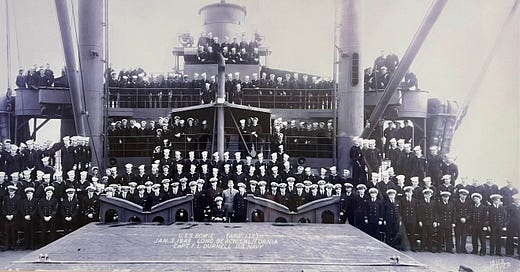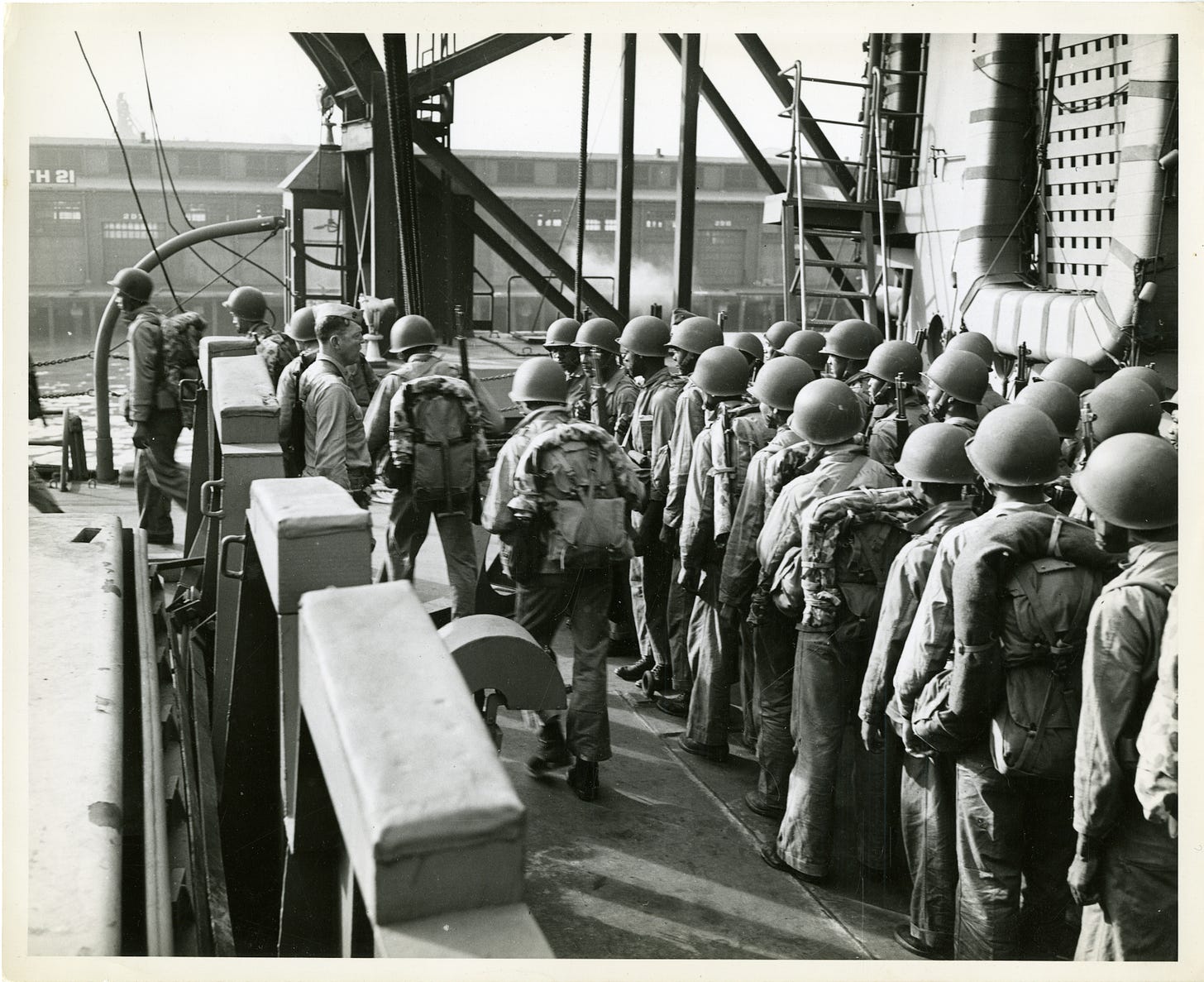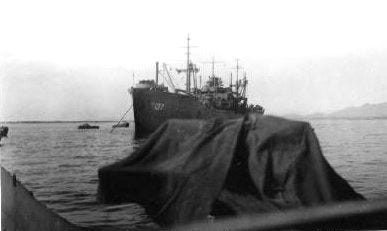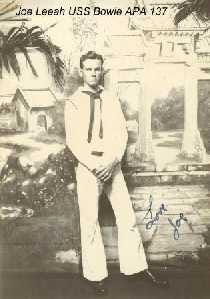A NAVY STORY
Frank Lenox Durnell was born in 1901 in the agricultural hub of Paxton, Ohio. His father Charles, was 43 and his mother Hattie, was 32 —older parents. Studious Frank, age 18, went off to the US Naval Academy and apparently never looked back. After graduation and his commissioning as an officer in the United States Navy, he married his sweetheart Fae and off they went. His navy career took him and bride to places like pre-war China, Guam, Hawaii and Puget Sound (where he skippered a tugboat).
My mother was his eldest, and attended a new school almost every year until college.
The young officer and his family were in the peacetime navy for almost twenty years.
COMMANDING IN WAR
War came in 1941. Frank Durnell was tapped to command a Haskell-class attack transport, USS Bowie. He was her first, last and only skipper, from launch to mothballs.
Bowie’s hull was laid down on Halloween, 1944 in Wilmington, California by the Maritime Commission and launched by Christmas. Fully loaded she carried 2097 souls. Sailing her required 56 officers and 480 enlisted sailors. She was designed to carry 86 officers and 1,475 enlisted fighting troops into war fully equipped, including 20 landing craft, then to bring the casualties home. The Bowie was one of 388 attack transports built by the United States during World War Two.
She left the Naval Supply Depot in Oakland, CA for the Mariana Islands on February 20, 1945, passed through Hawaiian Islands, stopped at Eniwetok in the Marshall Islands for refueling and arrived at Guam on March 10. Frank Durnell had visited Guam and China in the mid-thirties on a tour that included his wife and young daughter.
The USS Bowie was not a typical ferry boat. Moving thousands of people while under threat from land, sea, and air took special consideration. The Bowie had help in the form of one 5"/38 dual-purpose gun, four twin 40mm guns, ten single 20mm guns, and later, a 40mm quad mount gun. She could fire back.
Attack transports work close in to the shore delivering troops into war zones. It seems almost a miracle that zero APAs were lost in WWII.
After embarking casualties in Saipan on the 18th, Bowie arrived at Pearl Harbor on March 27 with casualties from Iwo Jima and Saipan. Okinawa alone had produced an estimated 50,000 American casualties, including 12,000 dead. She conducted local operations in Hawaiian waters and engaged in upkeep in Pearl Harbor until mid-April, then loaded elements of the10th Army bound for the Okinawa campaign. She left Hawaii in a convoy with African-American troops (a novelty at that time in a segregated military, originally described by the sailor writing these notes as “Negro Troops”). Among the dead in Okinawa was their commander, Lieutenant General Simon Bolivar Buckner Jr., killed on June 18 by enemy artillery fire during the final offensive.
.The Bowie arrived at Eniwetok on April 24, 3100 miles from Hawaii, left on the thirtieth and arrived at Ulithi on May 3rd. Today Ulithi is about a forty-five minute flight from Yap. Leaving Ulithi on the 6th, they arrived at Hagushi Beach, Okinawa Japan to land troops and unload supplies. On May 10 two Jap(anese) suicide planes dived at the battleship USS New Mexico.
LEADERSHIP TEMPERAMENT
The USS Bowie’s yeoman (office manager), Joe Leeah, told decades later how seriously the threat of kamikaze suicide attacks were taken on the Bowie. The ship’s chaplain happened by the brig (ship’s jail) one day and found Leeah locked up.
What is this? what happened? the minister asked. Joe explained he had delivered some papers to the bridge while wearing a short-sleeved shirt. A long-sleeve order was in place because of potential powder burns, and Joe knew it because he had typed the orders. The Captain him gave a look and sent him to the brig to think about it until otherwise ordered. It took a visit from the chaplain for the captain to relent.
MOVING PEOPLE IN WAR
The Bowie left Okinawa for Hawaii on May 16, running a reverse track to Ulithi and Guam before arriving at Pearl Harbor on June 4, then on to San Francisco to disembark casualties and passengers on the ninth. After loading more cargo and troops, they were off to the Philippines (via Eniwetok and Ulithi), delivering the lot at Tacloban City.
She made one more round trip back to San Francisco and out to the Philippines before reporting back to Hawaii for two months of rehearsal landings at various locations on the islands. No doubt there was also some R&R.
Japan surrendered on September 2, 1945. The USS Bowie, meant for the ultimate invasion, had been spared by the first atomic bomb. The Bowie left Hawaii in a convoy headed for Japan and arrived in Saipan on the 13th for fuel and provisions, then delivered troops to Sasebo, Japan on the 24th. Putting troops ashore, she cleared for Subic Bay and Manila. On October 2, she moved to Lingayen Gulf and began embarking troops for occupation service in Japan. Two weeks later she was back in Japan with the troops, back to Guam and immediately off to San Diego, California.
THE END OF SERVICE
On November 27 the ship left the west coast for Guam again, to bring troops back home from the Pacific theater. She arrived exactly one month later. The fantail photo of a happy, relieved captain and crew at the top of this story was taken January 6 (see above).
Captain Durnell navigated one last voyage. The USS Bowie departed San Pedro to Norfolk VA for decommissioning on January 16, 1946. Captain Durnell guided the Bowie through the Panama Canal to Virginia, where she was struck from the Navy List and berthed with the National Defense Reserve Fleet in James River, VA. In 1973 the USS Bowie was sold to Union Minerals & Alloys Corporation for scrap.
My grandfather retired with heart problems and spent his last years painting desert scenes while taking in the air for his health. Frank and Fae Durnell lived in Long Beach. He died in 1954 at age 53, Fae in 1990 at 91. They are laid to rest at Ft. Rosecrans National Cemetery in San Diego.
A LEGACY
I did not know Papa but he has been with me all my life. Around 1960, Grannie took some of us grandchildren to lunch at the Officers Club at the Long Beach Naval Base. I was seven or eight.
With her braided head showing just above the steering wheel of her Chrysler Imperial, she navigated the sectioned floating bridge onto Terminal Island like an expert. As we reached the gate, a crisp marine in white gloves impressed us with a stiff salute (at my grandmother and the sticker in her windshield). We got a small look at her former life.
I remember the coat rack with its row of officers hats, a hushed atmosphere and the black stewards. Segregation was a new concept to me, and I noticed they all seemed to be black and everyone else was white. Carol asked how that made me felt. Curious.
I discovered Eggs Benedict on that trip to the “O Club”. I also felt an inkling of history, and began to understand how important the people who defend the country are to us. Grannie was obviously an officer’s widow out with her grandchildren, and we were treated well.
Today
Frank Durnell was a stand-up guy. Eyes were on Europe when the Japanese attacked Pearl Harbor on December 7, 1941. Eyes are on Europe again today, and the Pacific Theater is becoming hot again.
This essay from West Point Professor Terrence Goggin will help you understand.
Update June 12, 2025. Saturday (June 14), the first fascist-style military parade in US history will chew through DC at the pleasure of the country’s president. Cost to us: $50 million.
More than 2000 other towns and cities will hold quiet protests. Cost: sliding scale, and you sleep well at night.
Thank you to the family of shipmate Norman Deniston for posting the information about the Bowie’s tours of duties. And thank you, Joe Leeah, wherever you are.









